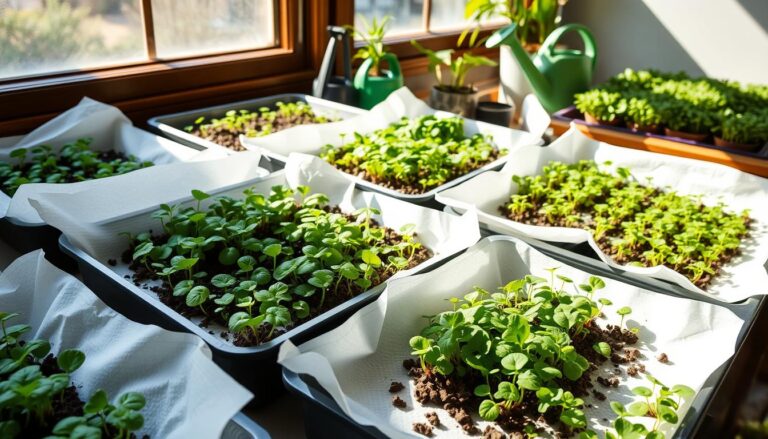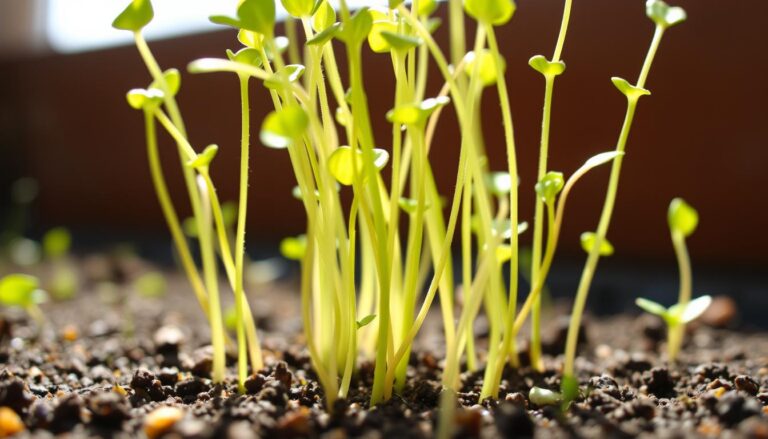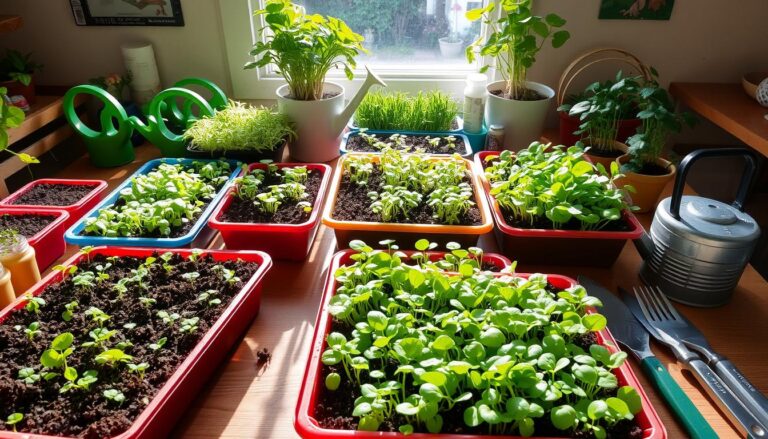How Often to Water Microgreens in Trays | Growing Guide
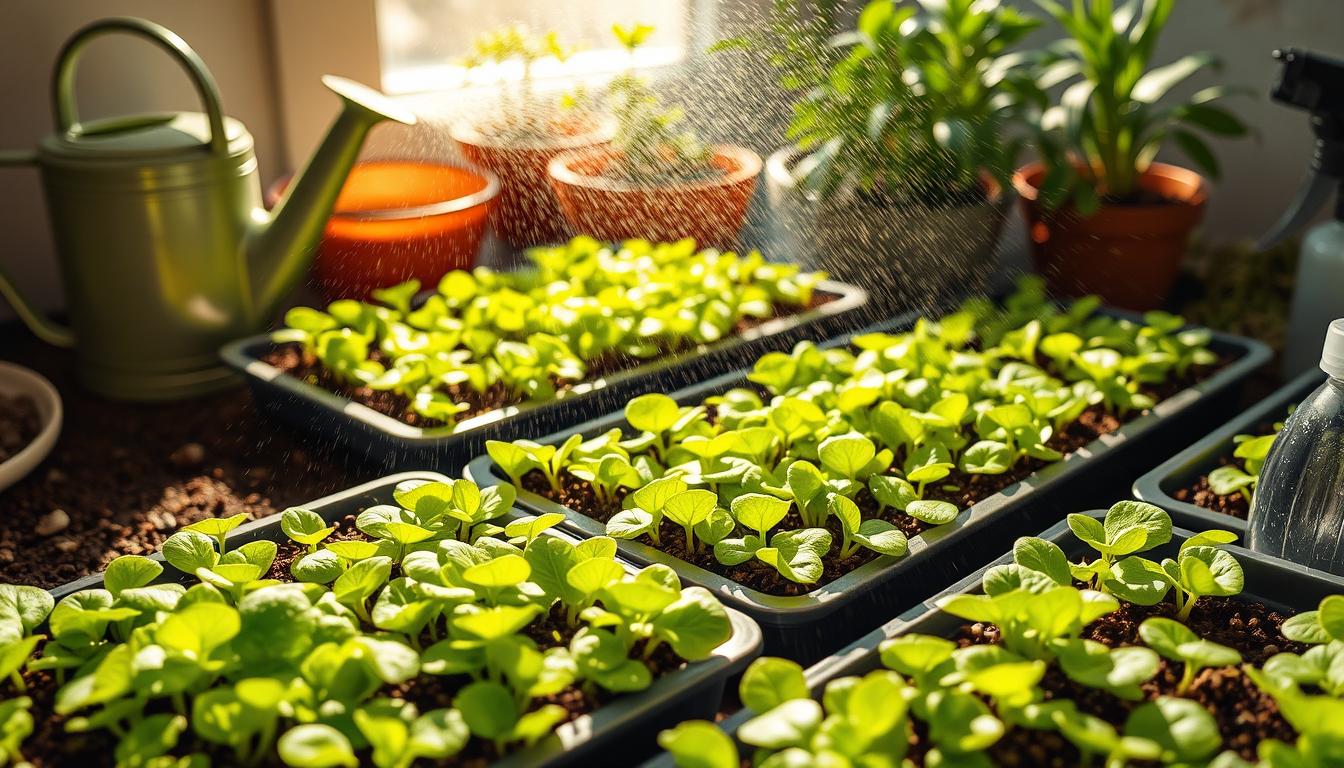
Ever wondered if you’re watering your microgreens too much or too little? This is a common worry for new growers. Finding the right balance of moisture is key to a successful harvest. Let’s explore how often to water microgreens in trays to keep these tiny greens healthy and thriving.
Introduction
Learning how to water microgreens right is essential for growing them well. These greens are full of nutrients and can thrive in small spaces. The right amount of water is key to their growth and stops problems like root rot.
The importance of correct watering frequency
Knowing how much water microgreen trays need is important for their health. The amount of water changes as they grow. For example, during the dark phase, they need steady moisture. As they grow, the amount of water needed changes to help their roots.
Impact on microgreen growth and health
Good microgreen watering techniques are vital for their health. The right amount of water helps them absorb nutrients. This makes them taste better and be more nutritious. Growing microgreens on paper towels shows how important it is to control moisture.
| Watering Method | Benefits | Best For |
|---|---|---|
| Bottom Watering | Reduces mold risk, keeps foliage dry | Small-scale/home growers |
| Top Watering | Easy to implement and control | Targeted watering needs |
| Automated Irrigation | Time-saving, consistent results | Commercial/large-scale operations |
By using the right watering methods, growers can get the best results. This ensures their microgreens are full of fibre, vitamins, and minerals. It also strengthens the grower’s bond with their garden.
Watering Schedule by Growth Stage : Days 1-3 (Germination Period)
Getting the water right is key in the first three days. It’s when your microgreens start growing. You must be careful to stop them from drying out.
Initial Watering Needs During Blackout Phase
Seeds need a bit of moisture to grow in the dark. Use a mister to wet the top third of the soil after planting. This keeps the seeds moist but not too wet.
Maintaining Moisture Under Dome
A dome keeps the air humid. This means you don’t need to water as often. It helps your seeds germinate well. You might not need to water again if you’ve set it up right.
When to Check Water Levels
Even though seeds don’t need much water at first, check the soil daily. Look for dry spots around the tray. If you find any, just mist a little to keep it moist.
| Day | Watering Needs | Action |
|---|---|---|
| 1 | Initial misting | Wet upper third of soil |
| 2-3 | Maintain moisture | Check daily, mist if needed |
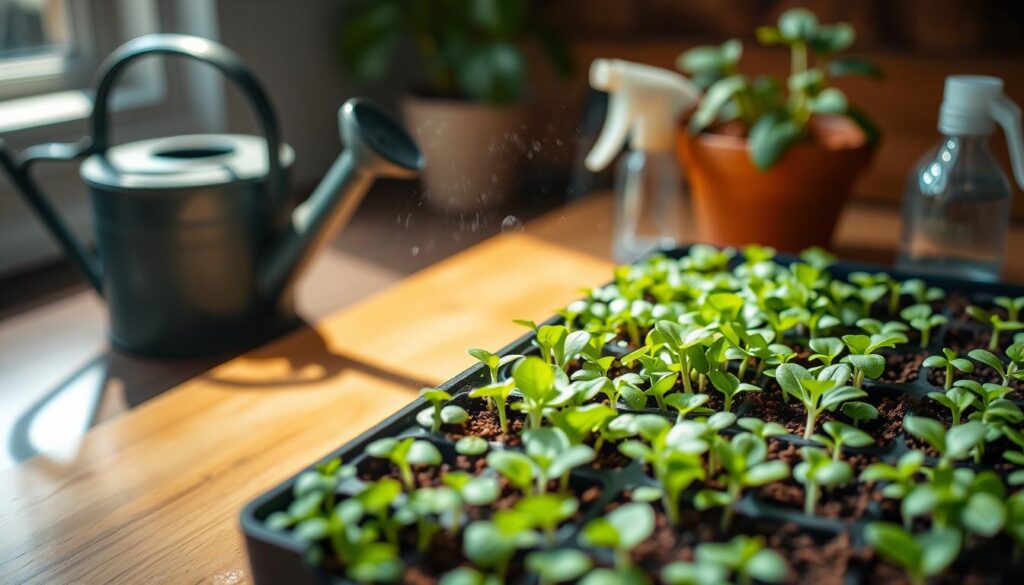
Don’t overwater your microgreens. It’s a common mistake. Using grow lights for herbs helps keep the right amount of moisture. Follow these tips to help your microgreens grow well from the start.
Watering Schedule by Growth Stage: Days 4-7 (Early Growth)
As your microgreens start growing, their water needs change. It’s important to keep the right moisture levels. Let’s look at how to do this well.
Watering Frequency After Removing Dome
After taking off the dome, you’ll need to water more often. Check your trays every day. This is because the greens dry out quicker without the dome.
Try to keep the soil moist but not too wet.
Bottom Watering vs. Misting
Bottom watering is best at this time. It helps the roots grow and stops mould. Here’s a simple guide:
| Tray Size | Water Amount |
|---|---|
| Home Microgreens Tray | 1/2 cup |
| 10×10 Tray | 1 cup |
| 10×20 Tray | 2 cups |
Don’t mist the top to avoid problems.
Signs That Watering is Needed
To see if your microgreens need water, lift the tray. If it’s light, like before, it’s time to water. Look out for these signs too:
- Slightly drooping leaves
- Soil pulling away from tray edges
- Slow growth rate
Getting the balance right is important. Too much water can harm them as much as too little. With time, you’ll get better at watering your microgreens.
Watering Schedule by Growth Stage: Days 8 Onwards (Mature Growth)
As microgreens grow, their water needs change. From day 8 onwards, keeping the soil just right is key for healthy growth. Let’s look at how often to water and the best ways to do it.
Daily Watering Requirements
Mature microgreens usually need water every day. But how often depends on things like the weather. Studies show that using efficient watering systems can help microgreens grow better.
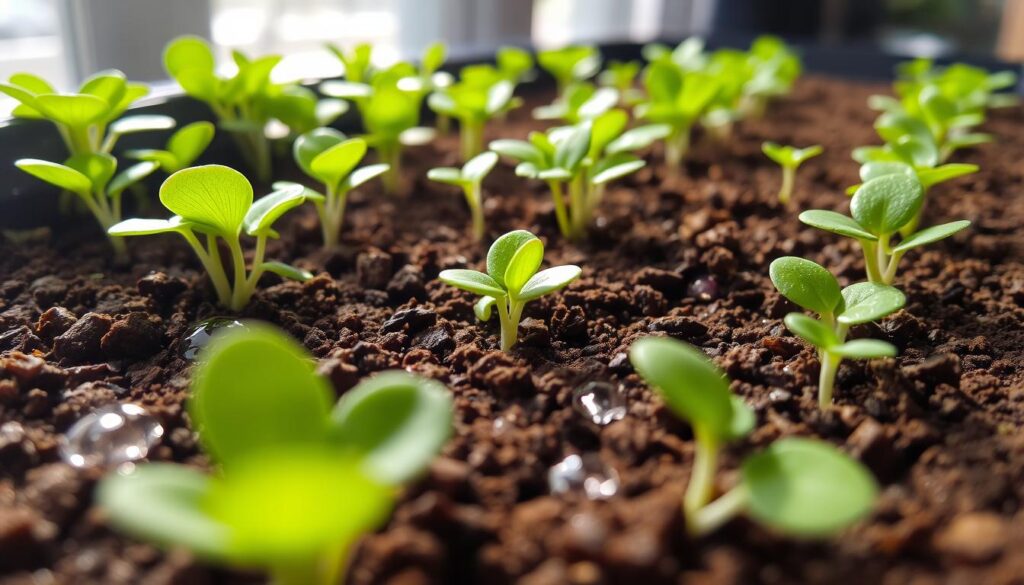
Best Time of Day to Water
Watering your microgreens in the early morning is best. This lets them soak up water before it gets hot. Kale microgreens do well with this schedule because of their health benefits.
How to Tell if Microgreens Need Water
It’s important to know when your microgreens need water. Here are some signs:
- Wilting leaves
- Dry, light-coloured soil
- Crisp, brittle stems
- Slow growth
To check if the soil is dry, press your finger into it. If it feels dry, it’s time to water. But be careful not to overwater, as this can cause mould or yellow leaves.
| Watering Aspect | Recommendation |
|---|---|
| Frequency | Daily or as needed |
| Best Time | Early morning |
| Method | Bottom watering or gentle misting |
| Water Amount | Until soil is moist but not saturated |
By following these tips and watching your microgreens, you’ll get a great harvest. Remember, Mediterranean herbs like rosemary and thyme need different amounts of water. So, adjust your watering if you’re growing these too.
Choosing Your Watering Method
Growers have two main options for watering microgreens: bottom watering and top watering. Each method has its benefits. Knowing these can help you pick the best for your garden.
Bottom Watering Microgreens
Bottom watering is a favourite among microgreen fans. It involves adding water to a tray under the plants. This lets them absorb moisture through holes in the container. It’s great for spreading moisture evenly and fighting off fungal diseases.
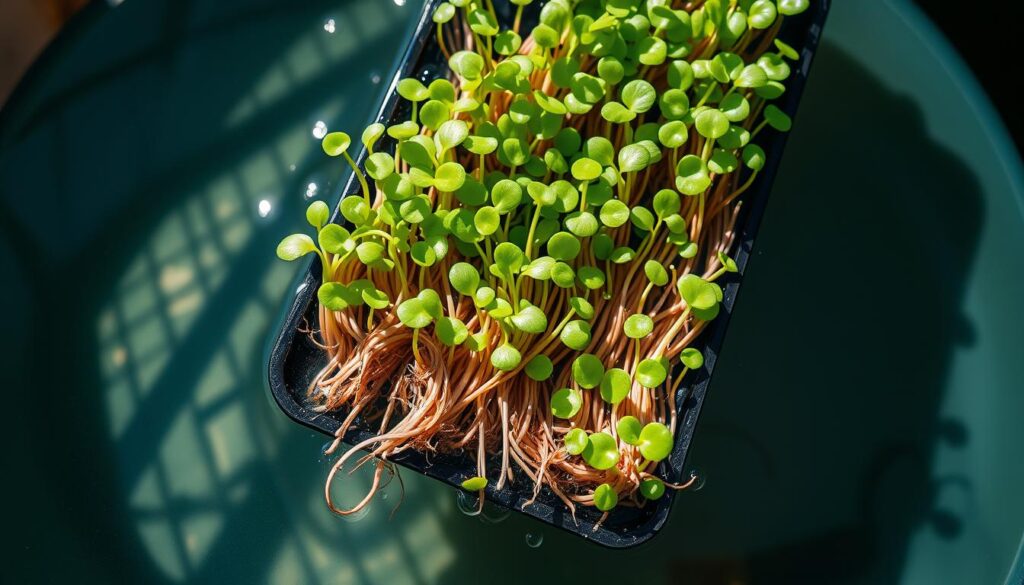
In an 8-day test, bottom-watered microgreens grew their roots fast. This method keeps humidity between 40% and 50%, preventing mould. It’s good for spinach and broccoli microgreens, ready in 7-14 and 10-15 days, respectively.
Top Watering Microgreens
Top watering means adding water to the soil’s surface. It’s needed sometimes but must be done carefully to avoid wetting leaves. This can cause mould or bacteria. It’s best for small plants like micro basil or micro broccoli, which need daily water.
The 8-day study found no big difference between bottom and top watering. But, watering regularly is key for healthy growth. Most microgreens need 12-16 hours of light a day and are ready in 10-30 days, depending on the type.
When picking a watering method, think about water quality and pH. The best pH for growing microgreens is slightly acidic, between 5.5 and 6.5. If you’re starting an indoor herb garden, these techniques work well for herbs too.
Signs of Improper Watering
Getting the watering right is key for growing healthy microgreens. Too much or too little water can cause problems. Knowing the signs of overwatering and underwatering is important for keeping your microgreens in top shape.
Overwatering Indicators
Spotting the signs of overwatering is critical for your plants’ health. Look out for yellow leaves, mould, and soil that stays wet. Too much water can cause damping off, a common issue. To stop this, make sure there’s good air flow and keep humidity between 40% and 50%.
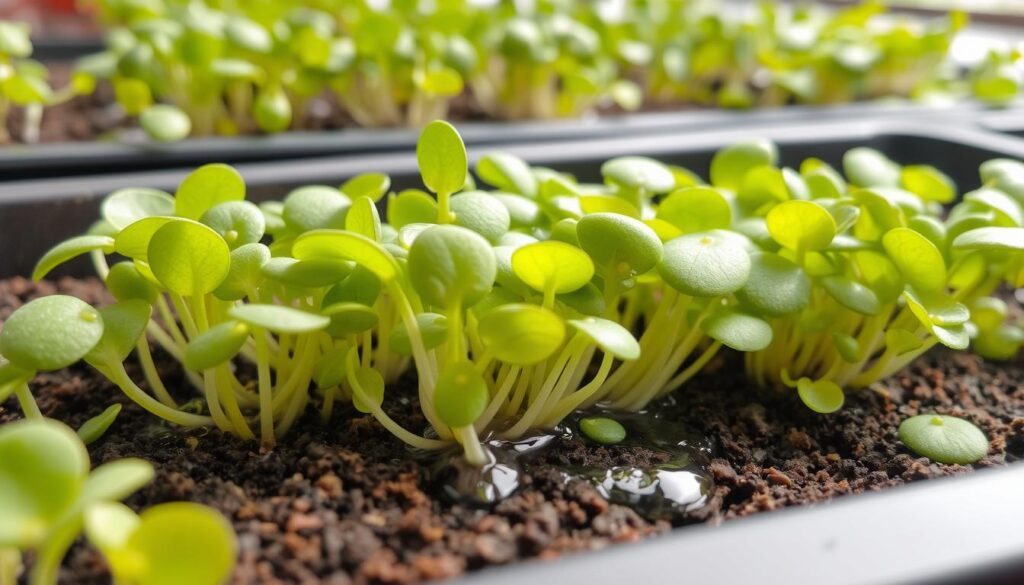
Underwatering Signs
Signs of underwatering include wilting, dry leaves, and slow growth. It can also cause uneven germination and spotty trays. To fix this, water your microgreens every day, more often as they grow. Larger plants like peas might need up to 2 cups of water twice a day.
| Watering Issue | Symptoms | Prevention |
|---|---|---|
| Overwatering | Yellowing leaves, mould growth | Improve ventilation, maintain 40-50% humidity |
| Underwatering | Wilting, dry leaves, slow growth | Water daily, increase frequency for larger plants |
To solve watering problems, check the soil moisture often and adjust as needed. Keeping your grow room clean and spacing seeds correctly also helps prevent mould. By spotting these signs, you can help your microgreens grow well and stay healthy.
Environmental Factors
Growing microgreens needs careful attention to their environment. These tiny greens are very sensitive to their surroundings. Knowing how different conditions affect their growth is key to success.
Impact of Room Temperature
Room temperature is very important for growing microgreens. Warmer temperatures can make them grow faster but they might need more water. For the best results, keep the temperature between 18-24°C (64-75°F). Using the right soil mix helps control temperature and moisture.
Humidity Effects on Watering Needs
Microgreens need different humidity levels at different stages. During germination, aim for 50-60% humidity. As they grow, reduce humidity to 40-50% to stop mould. Higher humidity means less water is needed, while drier air means more.
Air Circulation Considerations
Good air circulation is vital for healthy microgreens. It stops mould and helps them grow strong. Use a small fan to gently move air, but watch out for its drying effect.
| Environmental Factor | Ideal Range | Effect on Watering |
|---|---|---|
| Temperature | 18-24°C (64-75°F) | Higher temps increase water needs |
| Humidity | 40-60% | Lower humidity increases water needs |
| Air Circulation | Gentle, consistent | May increase water evaporation |
By managing these environmental factors, you can create the best growing conditions. Adjust your watering based on these conditions. Remember, each microgreen variety is different, so watch your plants closely and adjust as needed.
Conclusion
Learning how to water microgreens is key to growing them well. These greens are packed with nutrients and can be ready to eat in 10-14 days. They grow to 2-3 inches tall.
The first step is to water them regularly during the 3-5 day germination phase. Soil-grown microgreens need water twice a day. This helps them start growing strong.
It’s important to keep the growing area just right. The temperature should be between 65°F and 75°F (18°C to 24°C). Water should be around 70°F (20°C) for the best results.
Watering from the bottom is a good method. Add a cup of water twice a day for a 10/20 tray. But, make sure to remove any extra water to avoid problems like mould or root rot.
Microgreen growing tips stress the need for balance. Soil-grown microgreens usually don’t need extra nutrients in the water. But, it’s important to watch the soil moisture closely.
The thin soil and small growing area mean they dry out quickly. So, watering them regularly is essential. By following these tips and adjusting for your environment, you can harvest a lot of these healthy greens in just 2-3 weeks.



